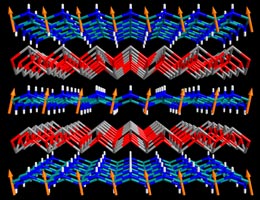Magnetic superconductor: Strange bedfellows

The new compound is made up of stacks of alternating superconducting iron selenide and ferromagnetic lithium-iron hydroxide layers. (Source: Dirk Johrendt)
Superconductivity and ferromagnetism – the “normal” form of magnetism, such as that found in the familiar horseshoe magnet – are like chalk and cheese: They generally don’t go together. Ferromagnets are magnetic because the parallel alignment of adjacent electron spins in the iron atoms generates a strong internal magnetic field.
Almost all known superconductors, on the other hand, form pairs of “anti-aligned” electrons and exclude magnetic field lines from their interiors. But LMU chemists have discovered a new material in which these two properties can coexist:
“We have synthesized a new compound which exhibits both characteristics at the same time: It is a ferromagnetic superconductor,” says Professor Dirk Johrendt of the Department of Chemistry. “This is an important advance, which opens up new research opportunities in the field,” he adds.
Ferromagnetic superconductors are not unknown, but they are exceedingly rare, and almost always exhibit both properties simultaneously only when they are cooled to temperatures close to absolute zero (-273°C). “The layered material which we have synthesized, (Li,Fe)OH(FeSe), has the great advantage that it works at higher temperatures, which are easier to achieve and handle in the laboratory,” says Johrendt.
The new compound is made up of stacks of alternating superconducting iron selenide (FeSe) and ferromagnetic lithium-iron hydroxide (Li,Fe)OH layers. When the material is cooled, electrical resistivity drops to zero in the iron selenide layer at temperatures below -230°C, and superconductivity emerges.
At somewhat lower temperatures, the iron atoms in the (Li,Fe)OH layer become ferromagnetic, but superconductivity persists nevertheless.
In cooperation with physicists from the Technical University in Dresden and the Paul Scherrer Institute in Villingen (Switzerland), the LMU researchers have demonstrated that the magnetic field generated by the (Li,Fe)OH layers penetrates into the interleaved superconducting layers – spontaneously and in the absence of externally applied fields.
This novel state of matter is referred to as a spontaneous vortex phase. The few substances which exhibit this effect cannot easily be chemically modified and require ultracold temperatures, making more detailed investigation very difficult.
“Our new compound for the first time gives us the chance to explore the influence of chemical modification on the coexistence of superconductivity and ferromagnetism, so that it should soon be possible to carry out more extensive studies of this fascinating phenomenon,” Johrendt concludes. (Angewandte Chemie 2014) göd
Media Contact
All latest news from the category: Life Sciences and Chemistry
Articles and reports from the Life Sciences and chemistry area deal with applied and basic research into modern biology, chemistry and human medicine.
Valuable information can be found on a range of life sciences fields including bacteriology, biochemistry, bionics, bioinformatics, biophysics, biotechnology, genetics, geobotany, human biology, marine biology, microbiology, molecular biology, cellular biology, zoology, bioinorganic chemistry, microchemistry and environmental chemistry.
Newest articles

High-energy-density aqueous battery based on halogen multi-electron transfer
Traditional non-aqueous lithium-ion batteries have a high energy density, but their safety is compromised due to the flammable organic electrolytes they utilize. Aqueous batteries use water as the solvent for…

First-ever combined heart pump and pig kidney transplant
…gives new hope to patient with terminal illness. Surgeons at NYU Langone Health performed the first-ever combined mechanical heart pump and gene-edited pig kidney transplant surgery in a 54-year-old woman…

Biophysics: Testing how well biomarkers work
LMU researchers have developed a method to determine how reliably target proteins can be labeled using super-resolution fluorescence microscopy. Modern microscopy techniques make it possible to examine the inner workings…





















